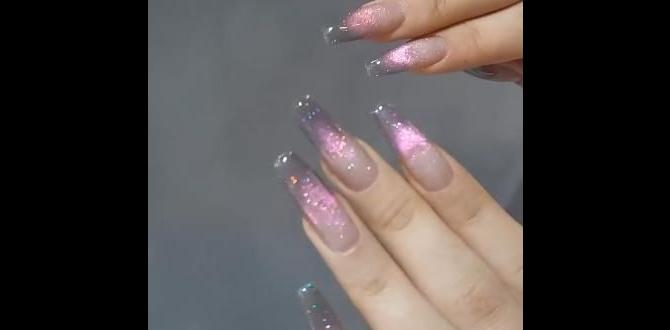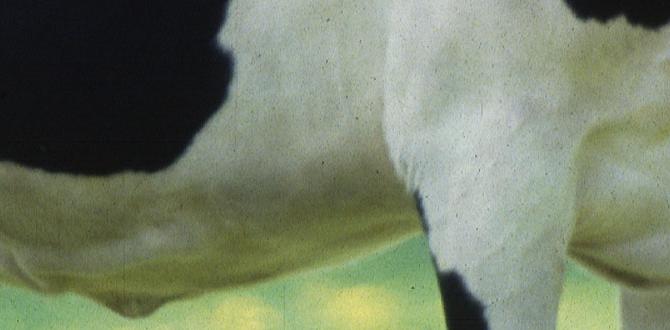Green nail art is a versatile and stylish choice that can range from subtle, earthy tones to vibrant, eye-catching designs. It’s a fantastic way to express creativity and embrace nature-inspired beauty. This guide will break down everything you need to know to create stunning green manicures, even if you’re a complete beginner!
Are you mesmerized by the beautiful shades of green you see in nail art but feel a bit intimidated to try it yourself? You’re not alone! Green can seem like a bold color to wear on your nails, or perhaps you’re unsure how to make it sophisticated and chic rather than overwhelming. But don’t worry, green nail art is incredibly versatile and surprisingly easy to master. It’s a color that can symbolize growth, renewal, and even a touch of luxury. Get ready to discover simple techniques and inspiring ideas to make your nails pop with gorgeous green hues. We’ll walk through everything from understanding different green shades to creating your own stunning designs.
What is Green Nail Art Exactly?
Green nail art, at its heart, is any nail design that incorporates shades of green. This can be as simple as a solid coat of your favorite green polish or as intricate as detailed patterns, gradients, or embellishments featuring green tones. Think of the lush leaves of a forest, the sparkling emeralds in jewelry, or the calming seafoam – green nail art draws inspiration from all these beautiful aspects of nature and beyond.
The “genius essential” aspect comes from its incredible adaptability. Green can be a neutral if you choose muted olive or sage tones. It can be a statement when you opt for neon lime or deep forest green. It’s a color that works for any season, any occasion, and any personal style. Whether you’re aiming for a minimalist look or a full-on artistic expression, green nails offer endless possibilities.
Why is Green Nail Art So Popular?
It’s more than just a trend; green nail art offers a unique blend of style and symbolism. Here’s why it’s a beauty favorite:
- Nature’s Palette: Green hues are deeply connected to nature, evoking feelings of calm, growth, and freshness. This connection resonates with many people looking for a grounding and aesthetically pleasing color.
- Versatility: From the softest mint to the deepest emerald, green offers a vast spectrum of shades. This means there’s a green for every skin tone, outfit, and mood.
- Sophistication & Fun: Green can be incredibly sophisticated, especially in richer jewel tones or matte finishes. It can also be playful and vibrant with brighter, more electric shades.
- Symbolism: Beyond nature, green can represent luck, wealth, and renewal. Wearing green can be a subtle way to embrace these positive energies.
- Trend Cycles: While classic, green has seen particular surges in popularity, especially when associated with specific aesthetics like cottagecore, forest bathing, or even retro vibes.
Getting Started with Green Nail Art: The Essentials
Before you can dive into creating beautiful green designs, you need a few basic tools. Don’t worry if you don’t have everything right away; you can build your collection as you go!
Essential Tools for Green Nail Art
- Nail Polish Remover: For cleaning up mistakes and starting with a clean slate.
- Cotton Pads/Balls: To apply the remover.
- Nail File and Buffer: To shape your nails and smooth the surface. A gentle buffer is key for healthy nails. You can learn more about proper nail filing techniques from resources like the American Academy of Dermatology’s nail care guidelines.
- Base Coat: This protects your natural nail from staining and helps polish adhere better.
- Top Coat: To seal your design, add shine, and prevent chipping.
- Green Nail Polish(es): The stars of the show! Start with a few shades you love.
- Fine-Tipped Brush or Dotting Tool: For creating details like dots, lines, or small shapes.
- Cuticle Pusher/Orange Stick: To gently push back your cuticles for a cleaner nail canvas.
Choosing Your Green Palette
The world of green is vast! Understanding different shades will help you pick the perfect one for your desired look.
Popular Shades of Green for Nail Art:
- Emerald Green: Rich, deep, and luxurious. Perfect for elegant, jewel-toned manicures.
- Forest Green: Dark, earthy, and sophisticated. Great for nature-inspired or moody designs.
- Olive Green: Muted, earthy, and subtle. A fantastic “neutral” green that pairs well with many colors.
- Sage Green: Soft, dusty, and calming. Ideal for minimalist and serene looks.
- Mint Green: Light, fresh, and pastel. A popular choice for spring and summer manicures.
- Lime Green/Neon Green: Bright, bold, and energetic. For a fun, statement-making look.
- Teal/Aqua: While technically blue-green, these shades often fall into the “green” category for nail art and offer a beautiful, watery vibe.
Mixing and matching different shades of green can create depth and interest. For example, try a base of forest green with delicate sage green leaf accents.
Beginner-Friendly Green Nail Art Designs
Ready to get creative? Here are some simple and effective green nail art designs perfect for beginners.
1. The Classic Green Mani
This is the simplest way to rock green nails. It’s all about choosing a shade you love and applying it flawlessly.
Steps:
- Start with clean, dry nails.
- Apply one coat of base coat and let it dry completely.
- Apply your chosen green polish in thin, even coats. Most polishes need two coats for full opacity. Allow each coat to dry partially before applying the next.
- Let the final coat dry for a few minutes.
- Apply a top coat for shine and durability.
2. Simple Green Ombre/Gradient
Create a beautiful fading effect with two or more shades of green.
What You’ll Need (in addition to essentials):
- Two shades of green polish (e.g., a lighter mint and a deeper sage)
- Makeup sponge (a regular kitchen sponge cut into small pieces works too)
- Tweezers (optional, for holding the sponge)
Steps:
- Apply base coat to clean nails and let dry.
- Apply your lighter green polish over the entire nail and let it dry.
- Apply a strip of lighter green polish and a strip of darker green polish side-by-side onto your makeup sponge.
- Quickly dab the sponge onto your nail, starting from the cuticle upwards, to transfer the colors. You might need to reapply polish to the sponge and dab again to build up the color.
- Repeat on all nails.
- Once dry, clean up any smudges around your nails with a brush dipped in nail polish remover.
- Apply a top coat to smooth out the gradient and add shine.
3. Polka Dots with Green Accents
Dots are an easy and classic way to add detail. You can use a dotting tool or even the tip of a toothpick!
What You’ll Need (in addition to essentials):
- A base color polish (could be green, white, black, or nude)
- A contrasting green polish for the dots
- Dotting tool or toothpick
Steps:
- Apply base coat and let dry.
- Paint your nails with your chosen base color and let it dry completely.
- Dip your dotting tool into the contrasting green polish.
- Gently press the dotting tool onto your nail to create a dot.
- Continue adding dots in your desired pattern (randomly scattered, in a line, forming a shape).
- Clean your dotting tool between colors or if it gets clumpy.
- Apply a top coat to seal.
4. Subtle Green French Tips
A twist on the classic French manicure using green polish for the tips.
Steps:
- Apply base coat and let dry.
- Apply a sheer nude or milky white polish to your entire nail (optional, for a cleaner look) and let dry.
- Use a fine-tipped brush or a French tip guide sticker. Dip the brush into your green polish and carefully paint a smile line along the tip of your nail. If using a guide, apply the sticker, paint the tip, and carefully remove the sticker.
- Clean up any wobbly lines with a fine brush and remover.
- Apply a top coat.
5. Green Leaf Accents
Add a touch of nature with simple painted leaves.
What You’ll Need (in addition to essentials):
- A base polish (e.g., nude, white, or a soft green)
- A darker green polish for the leaves
- A very fine-tipped brush
Steps:
- Apply base coat and let dry.
- Paint your nails with your chosen base color and let it dry completely.
- Dip your fine brush into the darker green polish.
- Create a small dot for the base of the leaf.
- With a single, light stroke, pull the brush away from the dot to form a leaf shape. You can make simple oval shapes or slightly pointed ones.
- Repeat on a few nails as accents. You can add a tiny dot of a lighter green for a highlight if you feel adventurous.
- Apply a top coat.
Advanced Green Nail Art Techniques (Once You’re Comfortable!)
Feeling a bit more confident? Here are a couple of techniques to explore next:
Marble Effect
This technique looks intricate but can be surprisingly achievable with a bit of practice.
What You’ll Need:
- Base coat
- A light green polish (or white) as the base
- Darker green polish(es)
- A clear polish
- A fine-tipped brush
- A flexible surface like a plastic bag or a non-porous mat (optional, for practicing)
Steps:
- Apply base coat and your chosen light base color. Let it dry completely.
- On a piece of plastic or your practice mat, “marble” your darker green polishes with a few drops of clear polish. Swirl them together gently with your brush to create a marbled effect. Don’t over-mix!
- Quickly pick up some of the marbled polish onto your fine-tipped brush.
- Gently paint wispy, irregular lines and swirls onto your nail, mimicking a marble pattern.
- While the polish is still wet, you can use a nail tool or toothpick to gently drag and blend the lines a bit more, creating that natural marble look.
- Clean up edges.
- Seal with a generous top coat once dry.
Stamping with Green Designs
Nail stamping uses special plates with etched designs and a stamper to transfer the image onto your nails.
What You’ll Need:
- Base coat and top coat
- A stamping plate with green-themed designs (leaves, geometric patterns, etc.)
- A stamper and scraper tool
- A highly pigmented green polish suitable for stamping (these are often more opaque than regular polish)
- Alcohol or nail polish remover (for cleaning the plate and stamper)
Steps:
- Apply base coat and your chosen base color, ensuring it’s fully dry.
- Apply a generous amount of your green stamping polish over the etched design on the plate.
- Hold the scraper at a 45-degree angle and quickly scrape off the excess polish.
- Immediately roll the stamper onto the design to pick it up.
- Quickly and evenly roll or press the stamper onto your nail.
- Clean up any smudges around your nail.
- Apply a top coat. Be careful not to smudge the design with the top coat brush when applying.
Tools & Their Uses: Green Nail Art Edition
Let’s dive a little deeper into some specific tools you might find helpful for your green nail art adventures.
| Tool | Purpose | Beginner Tip |
|---|---|---|
| Dotting Tools | Creating perfect dots of various sizes, small flowers, swirls, and other detailed elements. | Start with one or two sizes. Use the smaller end for tiny dots and accents, and the larger end for bigger polka dots. Clean between uses! |
| Fine-Lined Brushes (e.g., 7mm, 11mm, 15mm) | Drawing thin lines, intricate details, abstract shapes, fine-tuning designs, and clean-up. | A 7mm brush is great for super fine lines. A longer brush (like 11mm or 15mm) is good for sweeping lines and drawing out shapes. Always rinse with remover/alcohol after use. |
| Striping Tape | Creating crisp, straight lines and geometric patterns. | Apply to a fully dry nail. Carefully peel off the tape after the polish covering it has dried to a slightly tacky or fully dry state (experiment to see what works best for your polish!). |
| Nail Stamping Plates & Stamper | Transferring detailed, pre-etched designs onto the nail quickly. Great for intricate patterns like lace or foliage. | Practice on paper or a disposable nail tip first to get the hang of the speed and pressure required. Ensure your stamping polish is opaque and designed for stamping. |
| Cuticle Pusher/Orange Stick | Gently pushing back cuticles for a neat nail bed and cleaning up polish mistakes around the nail edge. | Always be gentle with your cuticles. For cleanup, dip the angled end or the stick in nail polish remover and carefully trace around your nail. |
Maintaining Your Green Masterpiece
Once your green nail art is complete, a little care goes a long way to keep it looking fresh and fabulous.
- Wear Gloves: When doing household chores, especially with cleaning products or prolonged water exposure, wear rubber gloves. This protects your polish and your nails.
- Moisturize: Keep your hands and cuticles hydrated with hand cream and cuticle oil daily. This prevents hangnails and keeps your nail beds looking healthy, which enhances any nail art.
- Reapply Top Coat: If you notice your top coat starting to lose its shine after a few days, apply another thin layer. This can revive the look and add extra protection.
- Avoid Harsh Activities: Try not to use your nails as tools, like scraping or prying. This can lead to chips and cracks.
- Touch-Ups: For minor chips, you might be able to carefully touch them up with your polish color and a fine brush, or simply reapply a top coat to seal the edge.
Frequently Asked Questions About Green Nail Art
Here are some common questions beginners have about green nail art:
Q1: Can I wear green nail polish if I have fair skin?
Absolutely! For fair skin, consider softer greens like mint, sage, or a pale jade. Deeper, muted greens can also look sophisticated. Avoid very bright, neon greens if you want a more subtle look, but if you love it, go for it! The key is finding the shade that makes you feel confident.
Q2: How do I prevent green polish from staining my nails?
The most crucial step is always using a good quality base coat. Apply 1-2 layers and let them dry completely before applying your green polish. Some darker or more vibrant greens are more prone to staining, so a good base coat is your absolute best defense.
Q3: What colors go well with green nail art?
Green is surprisingly versatile! It pairs beautifully with neutrals like white, cream, black, and beige. Metallics like gold and silver can add a touch of glam. For complementary colors, think pinks and reds for a bold contrast, or blues and purples for a harmonious, nature-inspired palette. Earthy tones like browns and tans also create a cohesive natural theme.
Q4: How do I get clean lines for French tips or geometric designs?
For clean lines, use striping tape applied to a fully dried base color. You can also use a fine-tipped brush dipped in nail polish remover to clean up any



